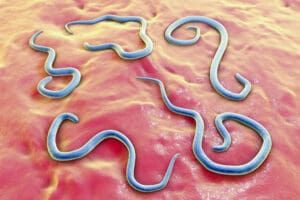
Internal parasites or worms are of great concern to both canines and their people. In some cases, the parasites are zoonotic (meaning humans can get them, too). In all cases, parasites can drain nutrients from your dog, and they are unsightly. In severe cases, a heavy parasite load can cause death.
The most common worms are roundworms or ascarids in puppies and tapeworms in any dog who has had fleas or hunts and eats his prey.
What to Do If You See Worms in Poop

If you find worms, bring them to your veterinarian for identification. For puppies, it’s important to do periodic microscopic inspection of feces (called “fecals”) even if you don’t see worms. Eggs can be identified under the microscope. Treatment is then tailored to any parasites found.
Roundworms are a zoonotic problem, meaning they can infect people as well as dogs, particularly children who might play in contaminated dirt on the ground and in playgrounds. Because humans are not a normal host for these parasites, the larval stages tend to migrate around human tissues. Common syndromes are visceral larva migrans with liver and pulmonary damage and ocular larva migrans, which has led to enucleation due to suspicion of cancer in some cases. I remember a friend growing up who had had an eye removed, and it turned out to be this parasite.
Roundworm infections need to be treated when detected and prevented, if possible. Almost all the monthly preventives for heartworm disease now cover the common intestinal parasites as well. Using one of these medications year-round can prevent roundworms in your dogs. It is also important to pick up after your dog to avoid fecal contamination of the environment.
Tapeworms in Dogs
Tapeworms are commonly noticed by owners in their dog’s stool. What you see most of time are really egg packets that get passed out with the feces. Occasionally a dog may vomit up whole tapeworms or pass adult worms in the stool, but that is uncommon.
The egg packets are visible to the naked eye and appear white and glistening when freshly eliminated on stool. Over time, they dry up and may look more like dried rice. Packets can stick on the hair around the rectum or in places where your dog rests, like his bed or your couch.
In general, tapeworms do not cause major health problems in dogs. A massive load might cause an intestinal impaction but rarely. The most common sign of tapeworm infestation is irritation around the anus. Dogs with tapeworms may lick and chew that area or “scoot” their butt, in a manner similar to a dog with an anal-gland problem.
The two tapeworm species seen most frequently in the United States are Taenia species and Dyplidium caninum. These two parasites have different life cycles and hosts. Your veterinarian can identify which type of tapeworm your dog has be looking at eggs under a microscope.
Taenia tapeworms come from ingested infected prey animals. For dogs, that means hunting, catching, killing, and eating wild rabbits. Many owners are shocked to find out that is how their dogs got tapeworms, but hunting urges are strong in almost all dogs, no matter what breed.
Dogs infected with Dyplidium have a different host. Fleas, or occasionally lice, are the intermediate host. A flea biting your dog won’t transmit tapeworms, but when your dog is biting and chewing from flea irritation, if he swallows some fleas, he can pick up tapeworms. (This is also true for any cats in your household, so if you have fleas, be prepared to treat your dogs and cats.)
Treating Tapeworms in Dogs
Treatment for tapeworms is slightly more complicated than treating for roundworms. The drugs praziquantel and epsiprantel are effective in most cases against Dyplidium, though some resistance to the drug seems to be developing. For Taenia species, praziquantel, epsiprantel, and fenbendazole are effective. Unlike roundworm treatment, where virtually all heartworm preventives contain medications to catch them, only a couple of these monthly medications (like Drontal Plus and Interecptor Plus) also cover tapeworms.
While tapeworms don’t have the overall health and zoonotic concerns of ascarids, aesthetically, it is desirable to treat them. No one wants dried (or fresh) tapeworm segments, or proglottids on their dog or on their furniture. Once again, prevention is key.
Once your veterinarian has identified the type of tapeworm your dog has, you can make a plan. Tapeworm eggs are almost never found on a fecal flotation (a laboratory method that separates the eggs from the feces), so you need to bring in some of the egg packets. Fresh or dried feces generally work. Your veterinarian will examine the packets under the microscope to identity the exact species involved.
If Taenia species are found, you need to limit your dog’s opportunities for hunting or be prepared to periodically deworm for these tapeworms. For Dyplidium tapeworms, you need to eliminate any fleas or lice. That means treating pets and the environment.
An unusual tapeworm, Echinococcus, can cause problems in dogs via liver damage and cysts. This is also a zoonotic parasite and can cause serious health problems in humans. Ungulates (hoofed animals such as sheep and deer) are intermediate hosts, along with some rodent species. Currently, cases of this parasite are very unusual in the United States with most cases confined to sheep herding dogs.


